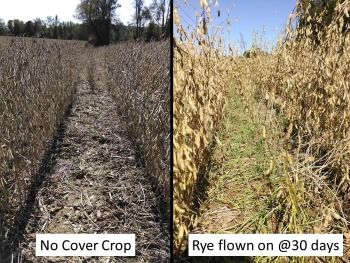Protect Your Soil and Improve Water Quality by Planting Cover Crops
October 19, 2017

Improve the health of your soil and the quality of lakes and streams in your neighborhood, by adding a simple agricultural practice to your urban and suburban autumn lawn care regimen. That practice is the planting of cover crops. At the end of the summer growing season, when you are ready to take a breather from gardening and yard work, your soil is not yet ready to rest. One final effort to plant a cover crop in the fall can make a huge difference over the winter toward improving your soil and helping to reduce soil erosion, stormwater runoff, and non-point source pollution entering our streams and rivers in the spring.
Cover crops, also known as green manures, are an excellent tool for vegetable gardeners, especially when manure and compost are not available. Even small gardens will benefit from the use of cover crops. The tilling, weeding, harvesting, and foot traffic of most home gardens tends to destroy the structure of the soil. Planting cover crops is an easy way to revitalize the soil and promote subsequent plant growth. Cover crops are planted in vacant space and instead of being harvested, are worked into the soil after they mature. They provide a number of advantages to the otherwise unhealthy condition of bare soil during your garden’s off-season.
Cover crops help to retain the soil, lessen erosion, and decrease the impact of rainfall on the garden by slowing the runoff of the rainwater. They also reduce soil compaction, suppress weed growth, and reduce the leaching out of nutrients from the soil. Cover crop top growth adds organic matter when it combines with the soil. The root system also provides organic matter and opens passageways that help improve air and water movement in the soil. Scientific studies have shown that cover crops actually drill down into the soil, some as much as six feet. When they decompose, the next crop planted will follow the rooting network laid out by the cover crop.
If you think that you might like to try planting cover crops this fall, consider what combination of cover crops to plant based on your garden’s needs.
- If you have difficult clay soils, then use the winter wheat and winter rye because they develop massive root systems which are great for breaking up the tight clay soils.
- Sow oats if this is your first time trying a cover crop or if you want to be able to plant early spring vegetables. Oats are killed by the first hard freeze and leave a brown decomposing mat in spring.
- Combine legumes (nitrogen-fixing plants from the pea and bean family) with non-legumes when possible.
- When you plant your cover crop make sure that the seed makes direct contact with the soil so that it will germinate.
- If you wait until very late in the fall to plant cover crops, your best bet to plant is cereal rye because it is the most cold-hardy of the cover crops.
- If you want to boost your soil’s organic matter and nutrient content using plants exclusively, plant oats mixed with cold-hardy winter peas in early fall.
Adapted from Summit Soil & Water Conservation District.


